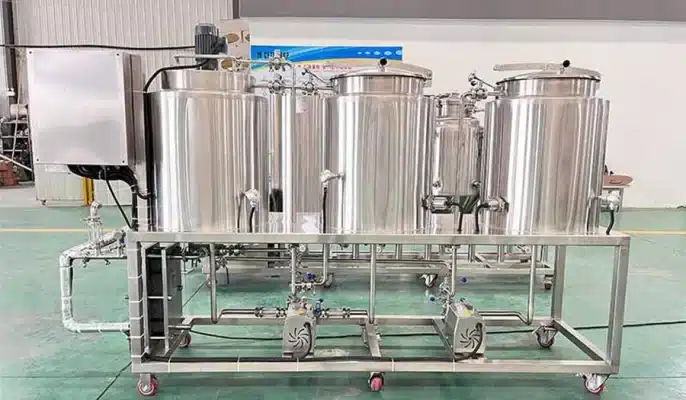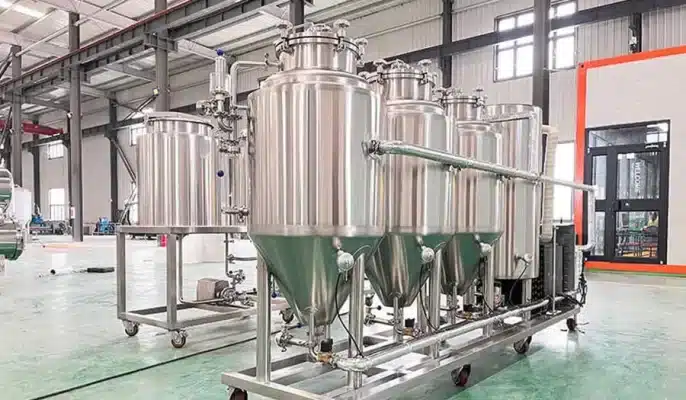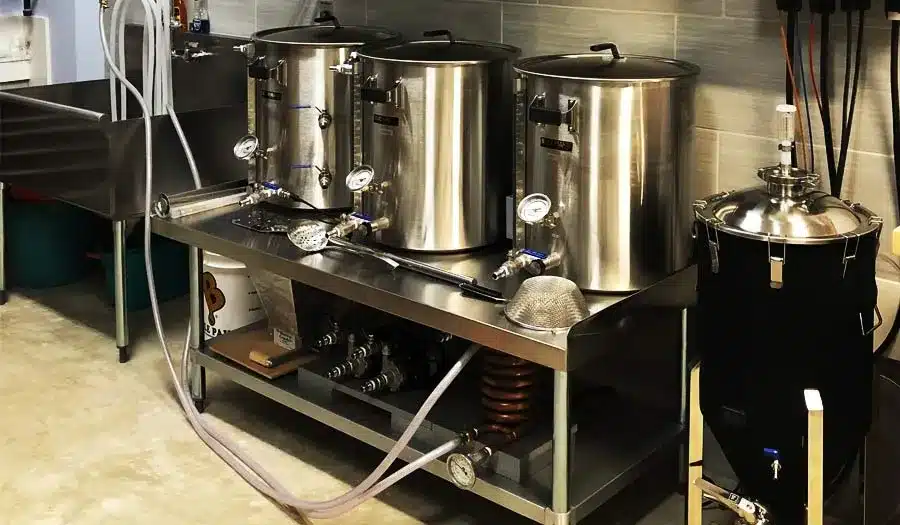Mini-brewery has emerged in recent years as people pursue handcrafted brewing techniques and unique flavors. Compared with large industrial breweries, mini-breweries can not only provide diversified and personalized products but also bring a humanized consumer experience. However, the equipment and technology required to establish a mini brewery successfully are important factors that many entrepreneurs overlook. This article will discuss the main brewing equipment mini breweries require, including its functions.
Che cos'è un mini birrificio?
A mini beer brewing system is essentially a smaller version of a commercial brewery. Designed for personal use, these systems allow brewers and craft beer enthusiasts to brew their beer at home. They come in a variety of sizes but are usually compact enough to fit on a kitchen counter or in a small storage space.
Comprising a variety of components such as fermenters, wort chillers, brew kettles, etc., these systems are designed to simplify the brewing process. While large brewing equipment requires a lot of space and investment, mini systems are designed to be more affordable and easier to use, making them accessible to both beginners and experienced brewers.

Cos'è l'attrezzatura per il mini birrificio?
- Mash tun: A container used to mash grains to extract sugars. Insulation is usually used to maintain heat.
- Mashing barrel: Mashing is a crucial step in the mini brewing process, which converts starch in the raw materials into fermentable sugars. Mashing barrels are generally made of stainless steel and have good thermal insulation properties.
- Botte di fermentazione: An indispensable piece of equipment for small breweries. Its main function is to provide a closed environment in which yeast can be active and complete the fermentation process. The material of the fermentation barrel is usually stainless steel or food-grade plastic to ensure hygiene and corrosion resistance.
- Wort cooler: Before fermentation, the wort must be cooled to a temperature suitable for yeast reproduction, and the cooler is particularly important at this time. Commonly used coolers include plate coolers and tube coolers.
- Filter: After fermentation is completed, there is often some yeast precipitation and solid particles in the wine. Using filters can effectively remove these impurities. There are many types of filters, including coarse filters and fine filters.
- Airlock: A small device that prevents air from contaminating beer during fermentation.
- Hydrometer: A tool for measuring the density of wort and tracking the progress of fermentation.
- Thermometer: A tool for tracking the temperature of the mashing and boiling stages.
- Cleaning equipment: A clean environment is an important guarantee for producing high-quality wine, so suitable cleaning equipment is indispensable. The equipment usually includes high-pressure water guns, cleaning agent spraying systems, etc.
Mini Brewery Brewing Process
- Mashing: Mashing is the process of soaking crushed grains in hot water to activate enzymes, which convert starches into fermentable sugars. The mash is kept within a specific temperature range (usually 150°F to 160°F) for about an hour to fully dissolve the sugars.
- Bollitura: Dopo l'ammostamento, il liquido risultante (chiamato mosto) viene bollito. Questa fase è essenziale per sterilizzare la miscela e aggiungere il luppolo, che aggiunge amarezza, sapore e aroma alla birra. A seconda della ricetta, il luppolo può essere aggiunto in punti diversi del processo di bollitura per ottenere gusti diversi.
- Cooling: After the wort is boiled, it needs to be quickly cooled to a temperature suitable for yeast fermentation (usually around 70°F). This is when a wort chiller comes in handy. The rapid cooling process helps prevent contamination from wild bacteria and yeast.
- Fermentazione: Il mosto raffreddato viene trasferito in un serbatoio di fermentazione e viene aggiunto il lievito. La fermentazione è la fase in cui il lievito consuma gli zuccheri e li converte in alcol e anidride carbonica. La fermentazione può durare da una settimana a diversi mesi, a seconda dello stile di birra.
- Bottling/Kegging: Once fermentation is complete, the beer is either bottled or kegged. Some brewers may also choose to carbonate the beer at this stage by adding a small amount of sugar before sealing it in the bottle, or by using CO2 cans to keg.
- Carbonation: After bottling or kegging, the beer needs time to carbonate and mature. Depending on the style of the beer, this can take anywhere from a few weeks to a month.
How to maintain minibrewery equipment?
- Cleaning and disinfection: After each use, clean all equipment thoroughly with a suitable cleaner. Disinfect all equipment before use to prevent contamination. Use a rinse-free disinfectant according to the manufacturer’s instructions.
- Beer kettles and wort barrels: Clean and scrub the inside of beer kettles and wort barrels to remove any residue. Check for burnt residue and clean it with a suitable cleaner. Check heating elements for any buildup and clean as needed.
- Fermenters: After each use, clean and disinfect fermenters. Check for scratches or other blemishes that could harbor bacteria. If gaskets or seals show signs of wear, replace them.
- Airlocks and stoppers: Clean and disinfect airlocks and stoppers before use. Check for any cracks or damage and replace if necessary.
- Siphon and delivery equipment: Clean and disinfect siphon equipment before each use. Check the pipes for signs of wear or discoloration. Replace pipes regularly to prevent bacterial growth.
- Bottles and caps: Clean and sterilize bottles thoroughly before bottling. Check bottles for cracks or chips and discard if damaged. Check caps for deformation and replace if necessary.
- Regular cleaning: After each brew, equipment should be cleaned immediately to prevent yeast and residue accumulation. This includes fermentation tanks, mashing tanks, filters, etc.
Advantages and Disadvantages of Mini Brewing
|
ADVANTAGES |
DISADVANTAGES |
|
Compact and easy to fit in small spaces. |
Limited brewing capacity compared to commercial systems. |
|
Affordable and accessible for beginners. |
May not have advanced features for experienced brewers. |
|
Simplifies the brewing process, making it easy for anyone. |
Some systems require additional purchases for customization. |
|
Can produce high-quality beer at home. |
Maintenance can be time-consuming, especially with larger systems. |

FAQ
What is a mini brewing system?
A mini brewing system is a device designed for small-scale brewing, usually including mash, fermentation, filtration, cooling, and other functions. It provides a complete brewing solution suitable for small breweries or home use.
What is the capacity of a mini brewing system?
The capacity of a mini brewing system varies by brand and model, usually ranging from a few liters to hundreds of liters. Common home-use equipment is generally between 20 liters and 50 liters, while small commercial equipment can reach 200 liters.
Where can I buy mini brewing system equipment?
Mini brewing system equipment can be purchased at specialized brewing equipment stores or specialized brewing material suppliers, to grasp the brand and reviews to ensure product quality. Of course, you can also contact Micet Group directly.
Can I customize my mini brewing system?
Yes, many suppliers offer customization options, and Micet Group provides this service, especially for advanced models.




